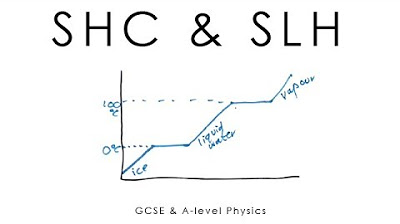Specific Heat Equation Stated Clearly
Summary
TLDRIn this video, the concept of specific heat is explained using a helpful triangle method for easier understanding. The equation Q = m * c * ΔT is broken down, where Q represents heat (measured in joules), m is mass, c is specific heat, and ΔT is the change in temperature. The video demonstrates how to use the triangle to solve for Q, mass, specific heat, and temperature change by rearranging the formula. The content aims to make learning about energy changes more accessible, with a reminder to spread kindness.
Takeaways
- 😀 Q represents the heat or energy change applied to an object.
- 😀 The formula for heat change is Q = Mass × Specific Heat × Change in Temperature.
- 😀 Q is always measured in joules, representing energy.
- 😀 Mass is usually measured in grams or kilograms.
- 😀 Specific heat is measured in joules per gram per Celsius/Kelvin.
- 😀 Temperature change is measured in either Celsius or Kelvin.
- 😀 To find the heat (Q), use the triangle: Q = Mass × Specific Heat × Temperature Change.
- 😀 To find the mass, use the formula: Mass = Q / (Specific Heat × Temperature Change).
- 😀 To find the specific heat, use the formula: Specific Heat = Q / (Mass × Temperature Change).
- 😀 To find the temperature change, use the formula: Temperature Change = Q / (Mass × Specific Heat).
- 😀 The video emphasizes kindness and encourages spreading positivity.
Q & A
What does 'Q' represent in the specific heat equation?
-'Q' represents the heat or energy change applied to an object, measured in joules.
What do you need to know to calculate 'Q'?
-To calculate 'Q', you need to know the mass of the object, its specific heat, and the change in temperature.
How is specific heat typically measured?
-Specific heat is typically measured in joules per gram per degree Celsius (J/g°C) or joules per kilogram per Kelvin (J/kg·K).
What are the possible units of mass when calculating specific heat?
-The mass can be measured in grams, kilograms, or any other unit of mass.
What is the formula for 'Q' in the specific heat equation?
-The formula for 'Q' is Q = m × C × ΔT, where 'm' is mass, 'C' is specific heat, and 'ΔT' is the change in temperature.
How would you solve for mass in the specific heat equation?
-To solve for mass, rearrange the equation to m = Q / (C × ΔT), where Q is the heat, C is the specific heat, and ΔT is the temperature change.
How can you calculate specific heat using the specific heat equation?
-To calculate specific heat, use the formula C = Q / (m × ΔT), where Q is the heat, m is the mass, and ΔT is the change in temperature.
What is the formula to solve for the change in temperature?
-To solve for the change in temperature, use the formula ΔT = Q / (m × C), where Q is the heat, m is the mass, and C is the specific heat.
Can the change in temperature be positive or negative?
-Yes, the change in temperature can be either positive or negative depending on whether heat is added (positive) or removed (negative) from the object.
What units are used to measure temperature change in the specific heat equation?
-Temperature change (ΔT) is typically measured in degrees Celsius (°C) or Kelvin (K), as both units have equivalent magnitudes for temperature change.
Outlines

This section is available to paid users only. Please upgrade to access this part.
Upgrade NowMindmap

This section is available to paid users only. Please upgrade to access this part.
Upgrade NowKeywords

This section is available to paid users only. Please upgrade to access this part.
Upgrade NowHighlights

This section is available to paid users only. Please upgrade to access this part.
Upgrade NowTranscripts

This section is available to paid users only. Please upgrade to access this part.
Upgrade NowBrowse More Related Video

Specific Heat of a Metal Lab

KALOR DAN PERUBAHAN SUHU | KALOR DAN PERPINDAHAN KALOR

Specific Heat Capacity + Latent Heat - GCSE & A-level Physics (full version)

Joule's Law Experiment

Termokimia (2) | Menentukan Perubahan Entalpi Reaksi berdasarkan Data Kalorimeter | Kimia kelas 11

Specific Heat Capacity | Matter | Physics | FuseSchool
5.0 / 5 (0 votes)